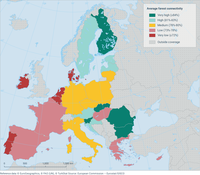
This viewer shows estimates of the impacts of renewable energy consumption since 2005 on the use of fossil fuels and emissions of greenhouse gases (GHGs) and air pollutants.

This figure shows the average forest connectivity for each EU member state in 2018. Forest connectivity is calculated as the share of land covered by forest or small woody features in a local neighbourhood of 10 hectares surrounding the focal forest grid cell.

This viewer outlines progress in the use of renewable energy sources in the EU and at country level, as well as per energy market sector and technology

The map shows the ecosystem area at risk of eutrophication for 2021

This chart shows the EU's raw material consumption.

Data viewer on projections of greenhouse gas (GHG) emissions reported to the EU/EEA by European countries. The viewer integrates historical GHG emissions from GHG inventories.

The development of fossil fuel subsidies in EU Member States, i.e. the trend between 2015 and 2022.

The trend in the amount of fossil fuel subsidies in the 27 EU Member States

The map shows the number of premature deaths (PDs) attributable to PM₂.₅ in 2021 at NUTS3 level for European countries. The PDs, which in absolute terms are higher for those NUTS3 level regions with the highest populations, have been normalised by 100,000 inhabitants, to make the numbers comparable among regions. For countries where NUTS3 regions are not available, the national value is shown.

This graph shows the EU contribution to the global phase-down of HFCs under the Kigali Amendment to the Montreal Protocol, which introduces limits to the consumption of HFCs, starting in 2019. HFC, hydrofluorocarbon; Mt, million tonnes. HFCs covered under the Montreal Protocol do not include HFC-161. A country’s baseline for the Montreal Protocol HFC phase-down is defined as the average HFC consumption during the period 2011-2013, plus 15% of the HCFC baseline in 1989, all expressed in million tonnes (Mt) CO2 equivalent. As set out in the Montreal Protocol, the HCFC baseline also includes 2.8% of 1989 chlorofluorocarbon (CFC) consumption.

This graph shows the progress of the hydrofluorocarbon (HFC) phase-down under EU regulation. HFC, hydrofluorocarbon; POM, placing on the market; RACHP, refrigeration, air conditioning and heat pump.
Data shown for 2022 are preliminary and subject to further validation by the European Commission. Values from 2007 to 2013 are based on the reporting obligations of the old F-gas Regulation (EC) No 842/2006 and are therefore not fully comparable with data from 2014 onwards (based on the obligations of the current F-gas Regulation (EU) No 517/2014).
The maximum quantities of the EU HFC phase-down shown for 2015-2019 apply to EU-28, for 2020 to EU-27 and UK. EU-27 maximum quantities for 2021 onwards have been recalculated to reflect the effects of Brexit.

Latest measurements from Europe's air quality monitoring network

This chart reports the number of newly registered electric cars (battery electric vehicles (BEV) and plug-in hybrid electric vehicles (PHEV)) in the EU-27 and non-EU EEA countries (i.e. Iceland, Norway and Switzerland)